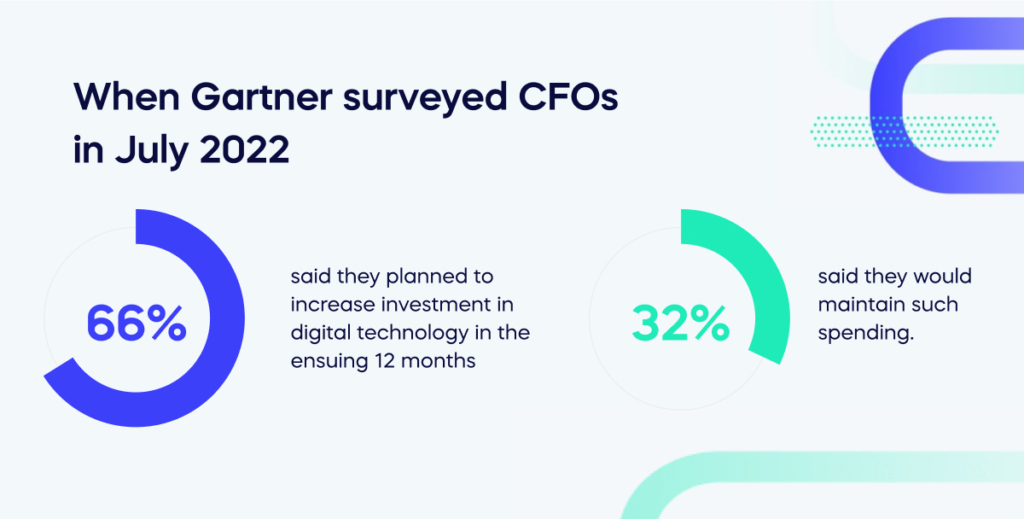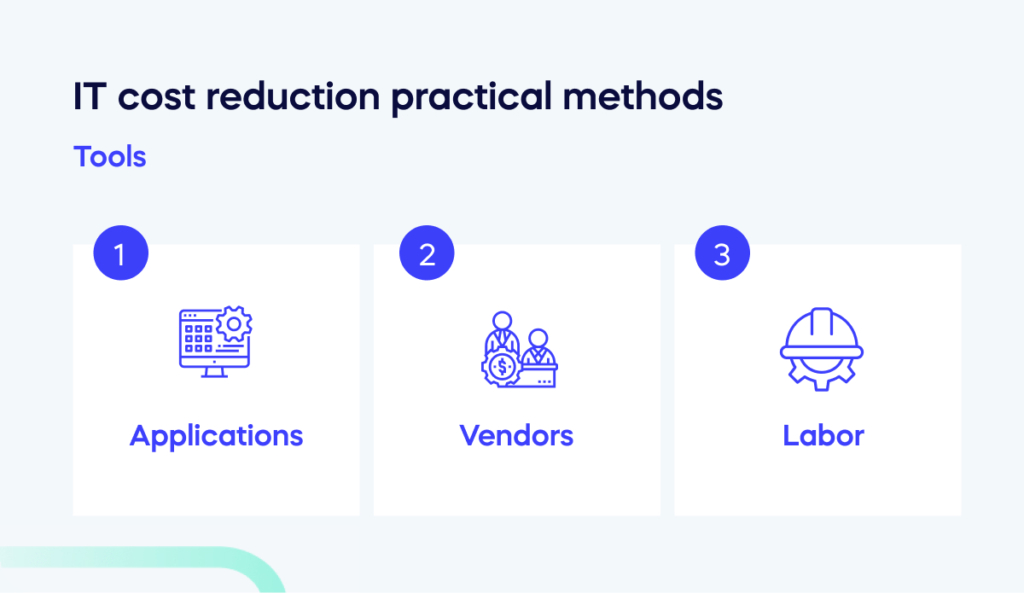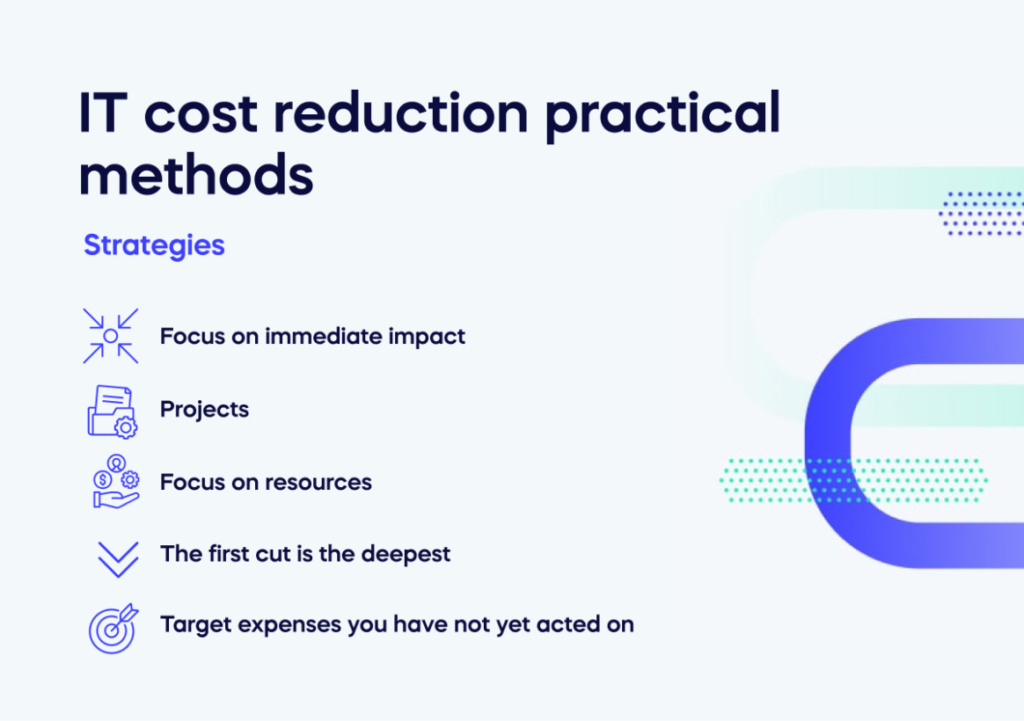CIOs and CFOs must balance the books daily in a rapidly changing market, but cutting labor costs doesn’t have to mean losing staff. Generating revenue with fewer resources is a vast challenge, but it is possible.

When Gartner surveyed CFOs in July 2022, 66% said they planned to increase investment in digital technology in the ensuing 12 months, and another 32% said they would maintain such spending. With such high spending, optimizing investment is essential to avoid wasted resources and growth opportunities.
Utilizing IT cost reduction effectively allows you to spend low and acquire high profits without compromising employee retention as you reduce personnel costs strategically without losing staff.
As part of our IT cost reduction playbook to show you how to eradicate IT costs the intelligent way, we cover the following topics:
- What is IT cost reduction?
- Why is IT cost reduction important?
- Who is in charge of IT cost reduction
- IT cost reduction practical methods
What is IT cost reduction?
IT cost reduction is finding ways to save money in the IT budget, also called IT cost optimization. Organizations can use saved money to make the budget smaller or get new technology to promote growth.
Why is IT cost reduction important?
Due to inflation and the possibility of a recession caused partly by the SVB collapse, organizations are under pressure to cut costs in the short term. This point is valid even if they intend to implement technology in the future to lower their operational expenses and stay ahead of competitors by reducing energy and hardware costs and other IT areas.
The dilemma for CIOs is finding ways to minimize the impact on the business’s long-term health while cutting costs.
According to our State of Digital Adoption 2022-23 report, companies wasted USD 16 million in 2022 on duplicate and unused software alone, highlighting the need to reduce costs in IT to eradicate waste.
Who is in charge of IT cost reduction?
You might assume that the CIO (chief information officer) or the CFO would charge IT cost reduction. But in truth, although these roles formulate and coordinate cost-saving strategies, IT cost reduction is the responsibility of every company member to implement into all processes to ensure it is successful.
When everyone works together and is mindful of the best methods to reduce IT costs, organizations make savings and can invest in growth for the benefit of every individual.
IT cost reduction practical methods
It is essential to look at practical methods to implement IT cost reduction successfully. It is helpful to separate these methods into tools and strategies to ensure you implement each one methodically.
Tools

Let’s begin with the tools of IT cost reduction practical methods.
Applications
Application management is a large part of any successful IT cost reduction project. Ensure you end your subscription to unused apps, constantly research new ones, and continue to collect number and experience-based feedback from employees about usage and their views on usefulness. Doing so will ensure you only use the best apps, reducing waste and boosting productivity.
The best way to ensure staff learns how to use a new app is to use a digital adoption platform (DAP), which contains in-app guidance and personalized learning tools to optimize adoption, mitigate risk and reduce costs. We found that our DAP delivered a projected 368% ROI in one study.
WalkMe’s DAP delivers a projected 368% ROI!
Vendors
To save money, streamline your vendors by canceling subscriptions to digital tools provided by vendors that provide services offered by other apps in your portfolio as part of your cost reduction initiatives. Ensure the amount of money you spend on a vendor matches the importance of the project, application, or service they support to reduce software licensing costs.
And finally, hold everyone accountable by having a centralized view of all your vendors.
Labor
What a company need to keep in mind because of the big picture and are being influenced indirectly – these are the things investors & the market is looking at the company need to think about it and keep it in mind because it can change, and it’s not always in the company’s power to change those things.
Look at the cost of staff for different apps, places, and job roles. Use this info to decide if you should wait to hire someone or move people to various locations that cost less money. Terminating your staff’s contracts is a last resort for their livelihood and company growth.
Change how you use your resources when you make changes to the app or business plans so it does not cause too much trouble.
Strategies

Next, let’s look at IT cost reduction strategies.
Focus on immediate impact
Focus on cutting down or temporarily halting expenses that will have a noticeable effect in the short rather than the long term. Consider targeting monthly or quarterly payments instead of annually.
Projects
To reduce operating costs and free up resources, prioritize investments into “run,” “grow,” and “transform” projects. Doing so will help identify which tasks can be suspended or restructured. It’s also essential to include run costs in the financial plan and report them explicitly so that the impact on individual cost centers is clear for future budget planning.
Focus on resources
Explain how each business unit’s IT budget translates into specific IT services. The more a business unit consumes IT services, the higher its IT spending will be. Encourage behavior changes that can reduce overall IT costs.
Ensure that IT projects and investments are aligned with business goals and supported by key personnel to allow you to reduce IT costs in tandem with the business. Use IT spend per employee benchmarks to identify any areas of excessive spending.
The first cut is the deepest
Organizations often fail to make sufficient cuts deep enough the first time, resulting in the need to revisit costs and repeat the process. A recent Gartner analysis (cited above) shows the need for IT cost reduction as it found that only 43% of leaders achieve the level of savings they set out to in the first year of cost reduction.
Doing so leads to a harmful and ineffective cycle of unpredictability, labor, and reduced productivity. These effects are hazardous in staff reductions that may undergo recurring downsizing processes.
Ensure your first cut is the deepest to avoid inefficiencies further into the project cycle.
Target expenses you have not yet acted on
It is essential to consider if you can recover payments and return prepayments to avoid waste. The first impact will be on charges that you have not committed to. Check the contracts for provisions related to renegotiation and termination.
Reduce IT costs with a DAP
Reducing IT costs is an essential part of any organization’s IT strategy. By making it part of your company culture, you can encourage staff at all levels to implement IT cost savings into every process. Another crucial component of any cost reduction strategy is a digital adoption platform. It enables businesses to train their staff in a personalized way with in-app guidance, saving resources on staff-to-staff training as the team learns at their own pace. Using a DAP can help you reduce IT costs, freeing up resources for growth, improvement, and digital resilience for the future.


